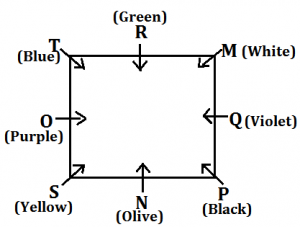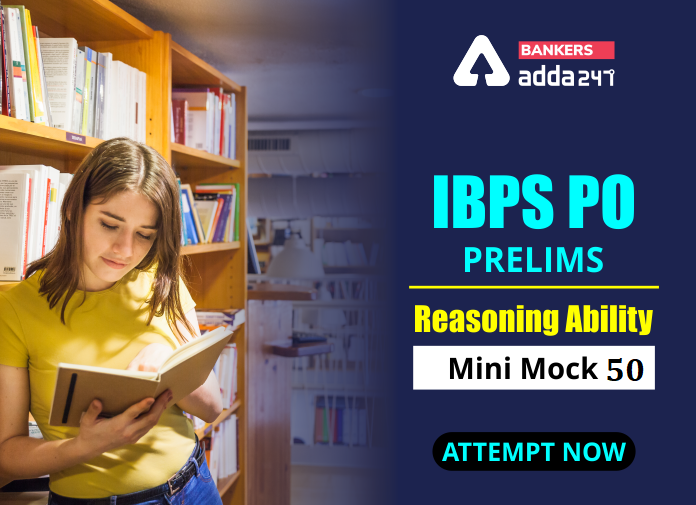Directions (1-5): Study the following information carefully and answer the questions given below:
Eight persons are sitting around a square table, facing the centre, in such that four persons sit at middle of the sides and four persons sit at the corners. Each of them likes different colour – blue, purple, olive, yellow, black, green, white and violet. The one who likes violet sits third to the right of S. O is an immediate neighbour of S. The one who likes olive sits second to the right of O. N sits third to the right of T. Only one person sits between O and the one who likes green. T neither likes violet nor olive colour. M and R are immediate neighbours of each other. Q does not like white colour. Neither M nor R likes violet colour. The one who likes blue colour sits second to the right of M. Only two people sit between P and the one who likes purple colour. P does not like violet colour. The one who likes yellow colour is not an immediate neighbour of the one who likes violet colour. The one who likes black colour sits second to the left of M. The one who likes Violet colour does not sit at the corner.
Q1. T likes which of the following colour?
(a) Violet
(b) Black
(c) Blue
(d) Green
(e) None of these
Q2. Who among the following sits second to the right of the one who likes violet colour?
(a) Q
(b) R
(c) O
(d) M
(e) None of these
Q3. Who among the following likes purple colour?
(a) N
(b) M
(c) Q
(d) O
(e) None of these
Q4. Who among the following sits opposite to the one who likes yellow colour?
(a) R
(b) The one who likes white colour
(c) T
(d) The one who likes purple colour
(e) None of these
Q5. Which of the following statement is true about Q?
(a) The one who likes black colour sits immediate right of Q
(b) Q likes blue colour
(c) T sits opposite to Q
(d) Q sits third to the right of S
(e) None is true
Directions (6-10): In these questions, a relationship between different elements is shown in the statements. The statements are followed by two conclusions. Give answer
Q6. Statement: A<B; G<D>E; G<F>B
Conclusion: I. E≥A II. A>E
(a) if either conclusion I or II is true.
(b) if only conclusion I is true.
(c) if neither conclusion I nor II is true.
(d) if only conclusion II is true.
(e) if both conclusions I and II are true.
Q7. Statement: D>K≥J; D≤S=H; I>K
Conclusion: I. K<H II. I>D
(a) if both conclusion I and II are true.
(b) if neither conclusion I nor II is true.
(c) if only conclusion I is true.
(d) if either conclusion I or II is true.
(e) if only conclusion II is true.
Q8. Statement: K<L<M≥S; K≥O>T
Conclusion: I. M>T II. M=T
(a) if only conclusion II is true.
(b) if either conclusion I or II is true.
(c) if neither conclusion I nor II is true.
(d) if only conclusion I is true.
(e) if both conclusions I and II are true.
Q9. Statement: Q> T>N; A>S>Q; A<M
Conclusion: I.N<A II. M>T
(a) if only conclusion II is true.
(b) if only conclusion I is true.
(c) if neither conclusion I nor II is true.
(d) if either conclusion I or II is true.
(e) if both conclusions I and II are true.
Q10. Statement: D>B≤C; F<M≤D; C=N
Conclusion: I. M≤C II. M>N
(a) if only conclusion II is true.
(b) if either conclusion I or II is true.
(c) if neither conclusion I nor II is true.
(d) if only conclusion I is true.
(e) if both conclusions I and II are true.
Directions (11-13): Study the following information carefully and answer the given questions.
Amongst five friends, A, B, C, D, E, each got different marks in the examination. A scored more than B but less than C. C scored 65 marks. D scored less marks than only E. The one who scored the minimum marks scored 60 marks and the one who scored the highest, scored 80 marks.
Q11. Who scored the second highest marks?
(a) B
(b) E
(c) D
(d) C
(e) A
Q12. Who is the most likely to have scored 62 marks?
(a) B
(b) A
(c) D
(d) E
(e) Either E or B
Q13. Who scored the lowest marks?
(a) B
(b) E
(c) D
(d) C
(e) A
Q14. In a class Nisha is 10th from the top and Aparna is 20th from the bottom. Naveen is 11 ranks above Aparna and 21 ranks below Nisha. How many students are there in the class?
(a) 60
(b) 61
(c) 62
(d) 58
(e) None of these
Q15. Rohit’s rank is 21st from the top and 15th from the bottom in the class. How many students are there in the class?
(a) 29
(b) 36
(c) 27
(d) 35
(e) None of these
Practice More Questions of Reasoning for Competitive Exams:
Solutions
Solutions (1-5):
Sol.
S1. Ans.(c)
S2. Ans.(b)
S3. Ans.(d)
S4. Ans.(b)
S5. Ans.(d)
Solutions (6-10):
S6. Ans.(a)
Sol. I. E≥A(false) II. A>E(false)
S7. Ans. (c)
Sol. I. K<H(true) II. I>D (False)
S8. Ans. (d)
Sol. I. M>T(true) II. M=T (False)
S9. Ans. (e)
Sol. I.N<A(true) II. M>T(true)
S10. Ans. (b)
Sol. I. M≤C (False) II. M>N (False)
Solutions (11-13):
Sol. E(80) > D > C(65) > A > B (60)
S11. Ans.(c)
S12. Ans.(b)
S13. Ans.(a)
S14. Ans.(b)
Sol. Total number of students in the class = 61
S15. Ans.(d)
Sol. Total number of students in the class= (21+15)-1= 35
Download PDF of this Reasoning Quiz for IBPS PO 2020
Practice with Crash Course and Online Test Series for IBPS PO Prelims:




 GA Capsule for SBI Clerk Mains 2025, Dow...
GA Capsule for SBI Clerk Mains 2025, Dow...
 The Hindu Review October 2022: Download ...
The Hindu Review October 2022: Download ...
 SBI CBO Admit Card 2025 Out at sbi.co.in...
SBI CBO Admit Card 2025 Out at sbi.co.in...


